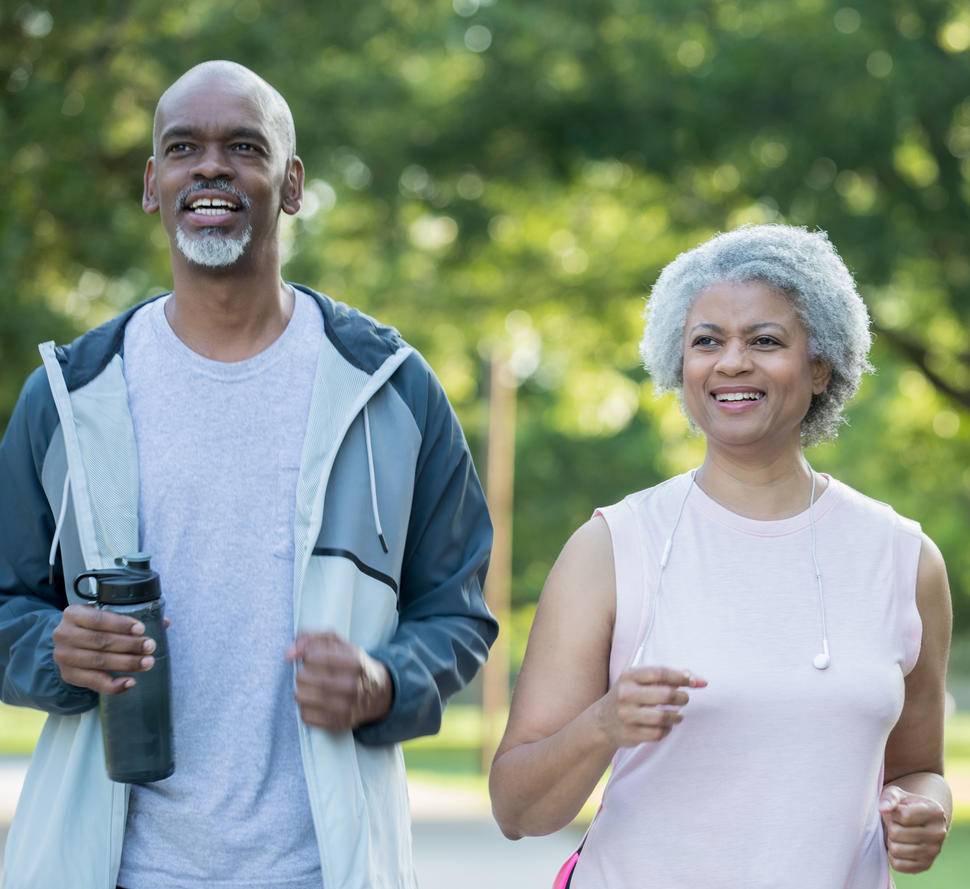Prescribing Exercise as Cancer Treatment: A Conversation with Dr. Kathryn Schmitz
, by NCI Staff
On October 16, 2019, an expert panel convened by the American College of Sports Medicine (ACSM) released updated guidance and recommendations on the role of physical activity and exercise in cancer prevention and survivorship. The panel was co-chaired by Kathryn Schmitz, Ph.D., M.P.H., of the Department of Public Health Sciences at the Penn State College of Medicine, and Charles Matthews, Ph.D., of NCI’s Division of Cancer Epidemiology and Genetics.
The recommendations, as outlined in three related publications, are the products of the panel’s comprehensive review of the scientific evidence on physical activity and cancer. In this conversation, Dr. Schmitz, immediate past-president of ACSM, discusses the research findings connecting physical activity with improved cancer outcomes and what these new guidelines mean for health care providers and survivors.
How would you describe the state of what we know about the role of exercise for people with cancer and for long-term survivors?
In the past, clinicians typically advised their cancer patients to rest and avoid physical activity. However, what we learned from early exercise research in the 1990s and 2000s contradicted that advice. In fact, the field of exercise oncology—exercise and cancer—has grown exponentially in the past decade. There are more than 1,000 randomized controlled trials in this field. Multiple large epidemiologic and preclinical studies have also been completed, all of which have expanded our knowledge.
We now have the evidence to tell us, with great confidence, that those living with and beyond cancer will benefit from being more physically active. We are at a point in the evolution of the field where we can dose exercise precisely, just as we do with drugs, to address several cancer-related health outcomes.
Which cancer-related health outcomes can be improved with exercise?
The ACSM panel found evidence that providing specific exercise prescriptions for a number of cancer-related health outcomes benefitted people living with or beyond cancer. As an example, we saw strong evidence that an exercise program consisting of a half hour of aerobic exercise three times weekly was sufficient to improve anxiety, depression, fatigue, quality of life, and physical function in cancer survivors.
There was also evidence of a benefit for most of those same outcomes from twice-weekly resistance exercise. However, anxiety and depression do not appear to be improved by resistance training alone, but they do improve with resistance training in combination with aerobic training. In addition, the panel concluded that there is no increased risk of lymphedema from twice-weekly resistance training.
The current evidence is still insufficient as to whether exercise can improve other health outcomes, such as peripheral neuropathy, cardiotoxicity, cognitive functioning, pain, or chemotherapy completion rate.
Can exercise improve survival for individuals with cancer?
Yes. We concluded from the evidence that exercise after a diagnosis of breast, colon, or prostate cancer is associated with longer survival. While there is insufficient evidence to draw the same conclusion for all cancer types, there are enough benefits of physical activity, in general, that we recommend that survivors of all cancers follow the general public health recommendations for physical activity: 2 and 1/2 to 5 hours per week of moderate-intensity activity, or 1 and 1/4 to 2 and 1/2 hours per week of vigorous activity.
Of course, an exercise regimen should be tailored to fit each cancer patient’s preference and functional status. To prescribe a safe and effective exercise program, the patient’s age, type and stage of cancer, treatment side effects, and other health considerations should be evaluated first.
Only a minority of cancer survivors exercise regularly. What will it take to shift the general understanding about the relationship between cancer and exercise?
We need a paradigm shift here, as we have had with exercise and heart disease. If we ask the average person on the street if exercise is good for the heart, he or she will say yes. That was not always the case, but at some point there was a shift. So, we need a multipronged initiative to encourage a change in thinking. A major effort should be geared toward increasing awareness of the importance of exercise among cancer patients, as well as providers, caregivers, and the general public.
ACSM has just started a new initiative called Moving Through Cancer, which focuses on increasing awareness of the value of exercise for cancer survivors, along with educating the cancer clinician workforce to refer, coordinate, and prescribe exercise; expanding opportunities to exercise; and shifting policy so that, by 2029, exercise is standard practice for all patients living with and beyond cancer.
We believe that increasing awareness will involve reaching out to mainstream and social media, updating textbooks for exercise science undergraduates, and developing continuing education for oncology practitioners, among other efforts.
My hope is that someday, if you ask anyone walking down the street whether exercise is valuable for cancer survivors, the response will be an emphatic “Yes.”
Can Exercise Help Treatment-Related Side Effects?
In addition to demonstrating a number of exercise-related benefits for cancer survivors, the ACSM reports also highlight several emerging areas of research, including whether exercise can ameliorate treatment-related side effects (e.g., cardiotoxicities, peripheral neuropathy) or facilitate treatment tolerance and effectiveness.
According to Frank Perna, Ed.D., Ph.D., program director in NCI’s Division of Cancer Control and Population Sciences (DCCPS), the evidence for exercise’s impact on many of these outcomes is promising but still insufficient. However, he explained, DCCPS is supporting studies that will help to strengthen the evidence base and address these questions and others related to the impact of exercise on cancer.
What is the most important take-home message for providers in these updated guidelines?
Since many cancer survivors are sedentary, the first and most important message providers can give their patients is that they don’t need to become marathoners to reap the benefits of exercise. Going from no exercise to some exercise will be useful for their health.
The ACSM's recommendation to providers is simple: Ask cancer patients about their physical activity. If their activity is inadequate, providers should advise their patients to do more.
Even if that is all providers have time to do, it demonstrates to patients that physical activity is an important part of managing their health and lays out the expectation that being physically active is healthier than being sedentary. This is true even for patients with advanced disease and those experiencing limitations, although those cancer patients will need a medically supervised program.
Are clinicians prepared for these discussions?
Adding yet another task to a clinician’s to-do list for patient encounters is a challenge. But providers who routinely ask their patients about physical activity and provide referrals to exercise programs told us their patients both enjoy and feel empowered by the exercise program. This, in turn, can become a bright spot in the clinical encounter and encourage the practice of discussing exercise.
The primary reason that providers do not have these discussions with cancer patients is lack of time. However, some have expressed concern that they don’t have the training needed to answer questions about exercise or that they may feel uncertain about the safety of exercise for a particular patient—and frankly, most people, and particularly health care providers, don’t like being faced with questions they cannot answer.
This is what the Moving Through Cancer initiative is eager to address. The website helps providers refer patients to places where their questions can be answered and high-quality exercise programs can be provided. Since most exercise programs require physician approval before patient participation, physicians are key to recommending such programs to their patients.
What sorts of behavioral and infrastructure changes are needed to incorporate exercise into standard cancer care?
In addition to raising awareness, we need to find ways to make exercise oncology a standard part of cancer care. This would include professional development for cancer care providers that incorporates training in how to have brief, informative, and effective conversations about physical activity with patients. It would also include professional development for rehabilitation practitioners, such as physiatrists, occupational, and physical therapists; and exercise science students and fitness professionals.
There is a need to develop instruction that can be dropped directly into curricula so that these practitioners are armed with knowledge about how best to help cancer patients become physically active, including how to design exercise prescriptions that deliver the right amount of exercise to meet the specific needs and abilities of their patients.
Sufficient resources must be allocated by insurers and communities so that high-quality exercise programs are widely available and accessible. The Moving Through Cancer initiative has a growing registry that we hope will become a trusted resource for oncology professionals to use for referrals to appropriate programs, as well as a resource to help patients and families find programs near them.
We also urge investigators to help advance the science in this area. There is a rich evidence base on exercise and cancer, so we’re encouraging researchers to conduct implementation science and health care delivery research to better understand how to encourage the adaptations needed so that all people living with and beyond cancer can be as active as possible.
Is there a role for survivors in helping to advance progress in this area?
There are multiple examples of patients being the catalyst to shift cancer care. Survivors and patient advocates can help create change in clinical cancer care by demanding that practitioners assess, advise, and refer patients to appropriate exercise programs.
The ACSM expert panel—which included NCI researchers Charles Matthews, Ph.D., Frank Perna, Ed.D., Ph.D., and Steven Moore, Ph.D., M.P.H.—reported its findings and associated guidelines in three recently published papers:
- Exercise Is Medicine in Oncology: Engaging Clinicians to Help Patients Move Through Cancer
- American College of Sports Medicine Roundtable Report on Physical Activity, Sedentary Behavior, and Cancer Prevention and Control
- Exercise Guidelines for Cancer Survivors: Consensus Statement from International Multidisciplinary Roundtable

